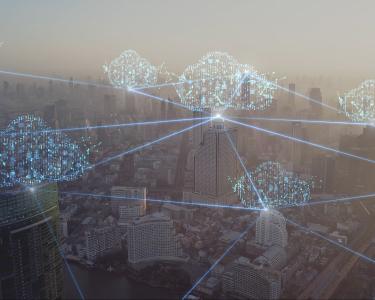Crafting the Future by Building the Backbone: Engineering Foundations for Future-Ready Enterprises

How products interact with consumers is going through a significant disruption, whether completely digital or device and platform. Gone are the days of standalone products operating in isolation. Today, it is a hyper-connected world where physical and digital assets converge and create a frictionless ecosystem of interconnected experiences. Washing machines, for instance, are no longer just appliances that run on buttons; they communicate with our smart devices, proactively suggest maintenance, and optimize energy consumption. Similarly, automobiles are evolving with advanced driver-assistance systems (ADAS), blurring the lines between human and machine interaction. This shift is driving a fundamental disruption in product and platform development.
Fundamental Challenges for a Product Engineering Team
This shift towards connected and intelligent products brings new challenges for product organizations. The pressure to deliver innovative, high-quality products faster than ever is immense. Engineering teams face several hurdles that can dampen their competitive edge. Some of them are:
- Time-to-Market: Demand for faster product releases is relentless. Without efficient development processes, release mechanisms, and effective feedback loops, organizations will struggle to adapt to changing market demands and risk losing ground to competitors who can iterate more quickly.
- Total Experiences: Consumers today expect intuitive, personalized, and seamless experiences across various devices and platforms. Without a strong focus on user-centric design, products will struggle to deliver experiences that cater to diverse user journeys and meet increasingly sophisticated expectations. Apart from the end consumer, it is essential that employees also have frictionless experience in complete lifecycles (Design->Prototyping->MVP->Scale->Post Sales). Taking it all together, it is now a total experience that includes all personas in the ecosystem.
- Changing Business Needs: Market volatility, evolving customer preferences, ambiguous requirements, and unexpected events can disrupt even the most meticulously planned product roadmaps. Organizations struggle to respond effectively to changing business needs without adaptive development approaches, potentially leading to missed opportunities and wasted resources.
- Quality and Reliability: Rapid release cycles can compromise product quality and reliability. Organizations risk deploying products with defects and broken experiences without rigorously verifying and validating compliance certifications, which can impact brand reputation. Streamlining the release process while maintaining quality becomes challenging. Achieving a faster time-to-market requires a robust engineering foundation that can support rapid changes, including swift rollouts and rollbacks of updates.
- Modernizing: Modernizing legacy systems can be complex and time-consuming. Organizations struggle to integrate new technologies without efficient modernization strategies and remain competitive in the rapidly evolving tech landscape. Modernization also sparks debate about whether to build or buy a particular component. There is also pressure on the product manager to move to a SaaS-based platform and generate inorganic revenue through data monetization.
- Security: As products become more interconnected and intelligent, they are increasingly exposed to cybersecurity threats. These include data breaches, unauthorized access, and vulnerabilities in the ecosystems. Without robust security protocols, organizations risk compromising sensitive user data and trust, making it critical to integrate security at every stage of product design and deployment.
- Sustainability: The sustainability of a product is no longer a good-to-have; it is taking center stage while experience is on the edge of it. Without a dedicated focus on sustainability, organizations will continue to face challenges in optimizing resource utilization, reducing waste, and promoting circular economy practices in product development. To date, sustainability adaption has only been in the physical product. In the newer world, software products are also crafted while considering sustainability, such as CPU cycles during computation, power consumption, embodied carbon in the hardware, and green architecture, to name a few.
- Talent: The demand for skilled engineers with expertise in AI, cloud computing, and emerging technologies is surging. Apart from technology, product development requires an entirely different mindset to execute. Without a proactive strategy to attract and retain top talent, companies face a talent gap that hinders their ability to develop and maintain complex, innovative products. The fierce competition for skilled individuals exacerbates this challenge.
Engineering Foundation:
In a world where products are rapidly evolving into interconnected, intelligent ecosystems, the challenges faced by product engineering teams are multifaceted. From accelerating time-to-market and ensuring product quality to addressing sustainability and modernizing legacy systems, organizations must adopt a holistic and adaptable approach. Central to this transformation is a strong Engineering Foundation, which acts as the backbone of scalable, reliable, and secure systems. This foundation is not just a technical marvel but the central nervous system of the enterprise's operational and technological ecosystem. It represents the principles, tools, processes, and practices that hold everything together, enabling the creation of scalable, reliable, and secure software systems. At its core, the Engineering Foundation ensures that all key domains work harmoniously, supporting the enterprise’s growth and adaptability.
Site Reliability Engineering (SRE) is the ecosystem's guardian, constantly ensuring system reliability, availability, and performance. It blends software engineering with IT operations, using monitoring, incident management, and capacity planning to keep the system resilient. DevSecOps, apart from the traditional release pipelines, integrates security into every stage of the software lifecycle. It automates critical tasks such as vulnerability detection, compliance checks, and secure coding to safeguard systems from threats. Meanwhile, security is the vigilant shield, focusing on network security, identity management, and regulatory compliance to maintain a robust defensive posture.
At the intersection of business and technology, BizOps bridges the gap, ensuring IT investments align with strategic goals, enabling collaboration between business and IT teams, optimizing processes, and supporting data-driven decision-making. MLOps is an innovator that seamlessly connects data science with engineering. It manages machine learning models' training, deployment, and monitoring, ensuring they deliver reliable and scalable results.
DevX (Developer Experience) empowers the creators by providing streamlined workflows, a tool ecosystem, and a friction-free environment, allowing them to innovate without distraction. Finally, Knowledge Management (KM) is the keeper of wisdom, capturing and sharing critical organizational knowledge. It ensures teams have easy access to documentation, onboarding people, and repositories, fostering collaboration and efficiency.
These elements together form a cohesive ecosystem, enabling the enterprise to deliver secure, scalable, high-quality software. This foundation aligns technical capabilities with business objectives while fostering adaptability and innovation.
Implementation Challenges Faced by Organizations
Implementing an Engineering Foundation comes with a few challenges that organizations must address. Monolith legacy systems with large digital footprints face friction when integrating modern tools and practices with outdated infrastructure. Cultural resistance is another challenge, where teams familiar with traditional methods may slowly adopt new processes or tools. Aligning business goals with technical capabilities can also be complex, particularly when stakeholders do not share a clear understanding of priorities. Additionally, organizations encounter a talent gap due to challenges in attracting skilled professionals capable of managing advanced technologies. Scalability issues occur when foundational elements like SRE and MLOps are not designed to grow with the business, leading to bottlenecks. Ensuring security compliance across interconnected systems and maintaining quality during rapid iterations is challenging without proper automation and robust frameworks. Last but not least, every organization has built bits and pieces of the foundation in a siloed manner, thereby causing technical debt. Addressing these challenges requires a strategic and phased approach that balances modernization with adaptability.
In a hyper-connected world where products are part of intelligent ecosystems, organizations must adopt a cohesive approach to development. By overcoming challenges and aligning technical capabilities with business goals, enterprises can craft scalable, future-ready solutions that deliver value to all personas—end-users, employees, products, and beyond.

Sneha leads global growth in Digital Product and Platform Engineering at Tech Mahindra. In her 13-year career, she has led Technology GTM, Product Marketing, and Business Strategy teams and spearheaded many transformational programs across organizations. Sneha has an MBA from IIM Calcutta and a B.E. in Mechanical Engineering from BIT Mesra.

Sanjay is an industry veteran with over two decades of experience. He is currently leading the design and architecture office of Digital Product & Platform Engineering. His breadth of experience covers multiple verticals, including manufacturing, logistics, automotive, ISV/IISV, smart cities, Retail, and CPG.More
Sanjay is an industry veteran with over two decades of experience. He is currently leading the design and architecture office of Digital Product & Platform Engineering. His breadth of experience covers multiple verticals, including manufacturing, logistics, automotive, ISV/IISV, smart cities, Retail, and CPG. Participation in multiple architecture boards reporting to Global CIOs for multi-geo large clients driving organizational technology guideline and blueprinting, cloud strategy, merger, and acquisition along with leveraging value stream maps into an enterprise perspective driving continuous strategy, innovation, and sustainability. Sanjay drives executive value stream-driven consulting on digital transformation, leading towards a composable enterprise through digital native assets. He holds a Master’s in Computers from Banaras Hindu University and a Bachelor's in Statistics from the University of Calcutta.
Less







